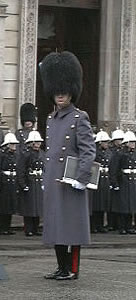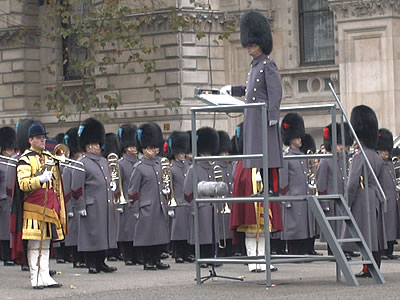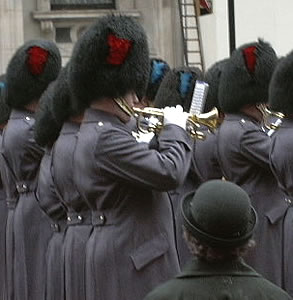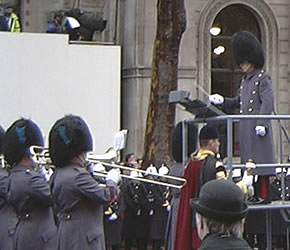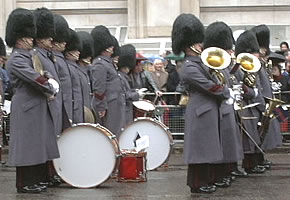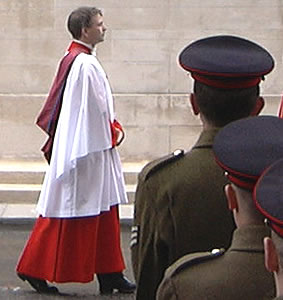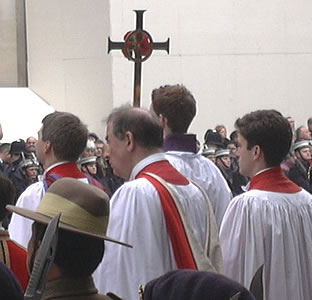|
|
Study, work or travel in the UK. British
culture and life.
|
|
|
|
|
|
|
|
|
|
|
|
|
|
|
|
|
|
|
|
|
|
|
|
|
|
|
|
|
|
|
|
|
|
|
|
|
Photographs of the Remembrance Sunday ceremony in London
|
At 11am on November 11th 1918, an armistice (peace agreement) was signed which
brought to an end the war between Britain and her allies and Germany. November
11th is called Armistice Day in Britain, and there is a two-minute silence at
11 o'clock. On either the Sunday before or the Sunday after Armistice Day (on
a day known as Remembrance Sunday) there is a ceremony in London at which people
remember those who have died or been injured in wars. The ceremony was first
held in 1921. Over 1.75 million soldiers and sailors from Britain and the Commonwealth
lost their lives in the two World Wars. Many other British forces have died
in more recent conflicts (including those in Korea, Malaya, Suez, Aden, Northern
Ireland, the Falkland Islands, Bosnia, Kosovo, Afghanistan and Iraq).
In
2011 Remembrance Sunday is on
Sunday 13 November
(for more details, see:
Ideas/Events/November)
The Remembrance Sunday service is centred around a simple stone monument called
the Cenotaph, which is in the middle of the road called Whitehall (
map).
It was built in 1919 to remember the dead of the First World War (1914-1919),
and the start and end dates of this war are engraved on two sides (using Roman
numerals). The start and end dates of the Second World War (1939-1945) were
later added to the other sides of the Cenotaph.
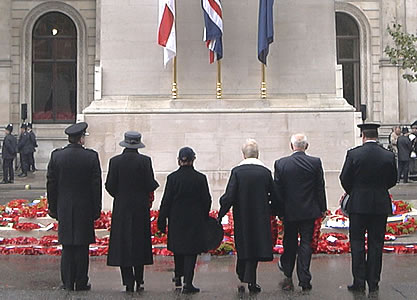 Paying tribute to war victims
Paying tribute to war victims |
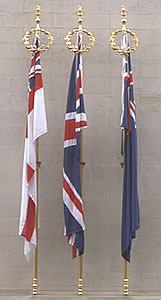 Flags of the armed services
Flags of the armed services |
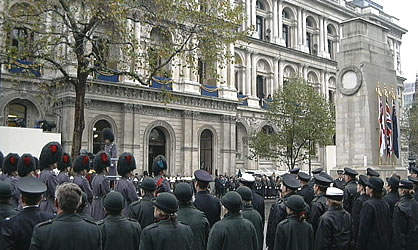 The Cenotaph is the centre of the Remembrance Sunday ceremony
The Cenotaph is the centre of the Remembrance Sunday ceremony |
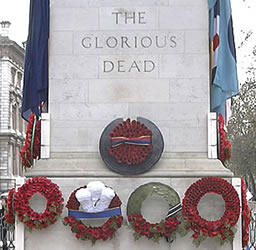 The front of the statue
The front of the statue |
 1914
1914
MCMXIV |
 1919
1919
MCMXIX |
 1939
1939
MCMXXXIX |
 1945
1945
MCMXLV |
Some members of the British Royal Family watch from balconies at the Foreign
Office building. The event is widely reported in the press, and is shown live
on BBC television (highlights are also shown in the evening). Members of the
public watch from both sides of the road, supervised by London's Metropolitan
Police.
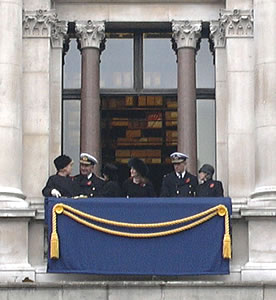 Balcony
Balcony |
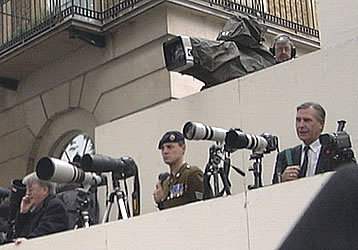 Many members of the media attend
Many members of the media attend |
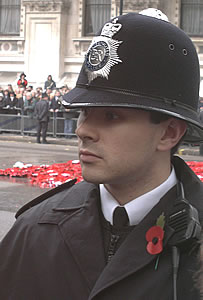 Metropolitan Police
Metropolitan Police |
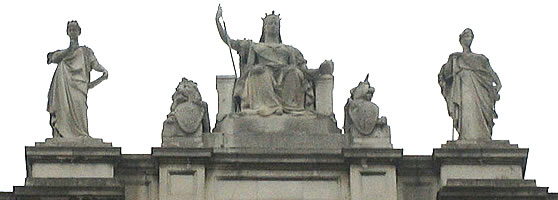 Statue on top of the Foreign Office building
Statue on top of the Foreign Office building |
At about 10:15am military bands arrive on the road called Whitehall. The "Massed
Bands of the Venerable Grenadier, Scots, Irish and Coldstream Guards"
play music while members of the armed services and political and religious
leaders assemble in the road. Some of the tunes played each year include Rule
Britannia, Men of Harlech, the Skye Boat Song and Nimrod (one of Elgar's Enigma
Variations).
Representatives of the army, navy and air force line up along Whitehall. At
11am you can hear the chimes of Big Ben (the large clock tower at the Houses
of Parliament). A cannon is fired on Horse Guards Parade after the first strike
of the bell: this marks the start of a two minute silence. The cannon is fired
again at the end of the two minutes. After this the "Last Post"
is played by buglers: this is often played when members of the armed services
who have been killed are buried.
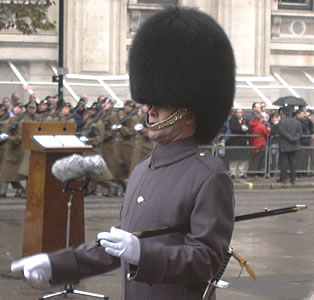 Soldiers are supervised by a member of the Guards
Soldiers are supervised by a member of the Guards |
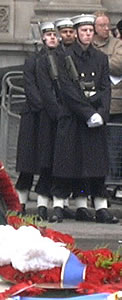 Navy, air force ...
Navy, air force ... |
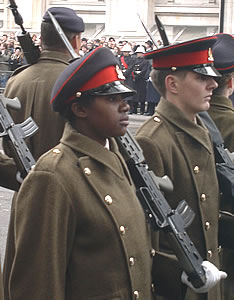 ... and army
... and army |
The Queen (Queen Elizabeth the Second) attends, dressed in black. Other members
of the Royal Family also take part in the ceremony.
Wreathes of poppies are laid - first by the Queen and Royal Family.
After this politicians leave wreathes, during which Beethoven's "Funeral
March Number 1" is played
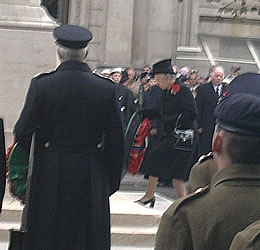 The Queen
The Queen |
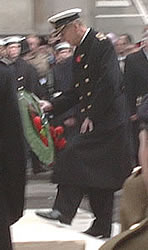 Duke of Edinburgh
Duke of Edinburgh |
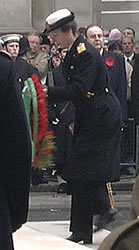 Princess Royal (Anne)
Princess Royal (Anne) |
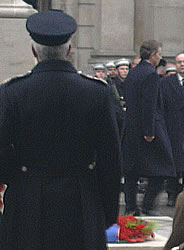 The British Prime Minister
The British Prime Minister |
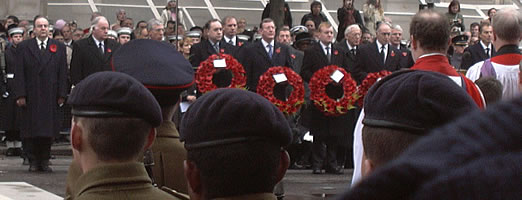 Leaders of British political parties
Leaders of British political parties |
High Commisioners (ambassadors) from almost 50 Commonwealth countries attend,
and also lay poppy wreathes. 3 million soldiers from the Commonwealth fought
in the First World War, and 5 million in the Second World War.
 Commonwealth representatives
Commonwealth representatives |
Representatives of the armed forces (the Army, Royal Navy and Royal Air Force),
merchant navy and police service also lay wreathes.
The area in front of the Cenotaph is soon full of poppies, like the fields of
Flanders after the First World War.
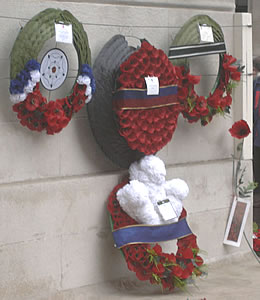 The Queen's wreath is in the centre
The Queen's wreath is in the centre |
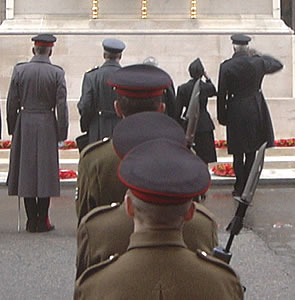 Members of armed services salute
Members of armed services salute |
A short service is led by clergy and choir members from the Chapels Royal. Representatives
from many of the world's major religions attend the event.
"God save the Queen" is played and the Queen and officials leave Whitehall.
Finally, about 10,000 veterans (current or past soldiers) come out onto Whitehall
and march past the Cenotaph. While they are marching, the public clap and the
military band play popular patriotic tunes from the world wars (such as "Pack
up your troubles", "There will always be an England" and "Colonel
Bogey"). The veterans continue past the Guards Memorial statue on Horse
Guards Road, before returning to Horse Guards Parade to take the salute.
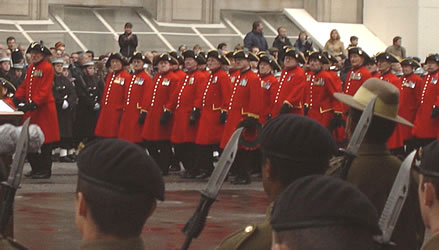 Chelsea Pensioners
Chelsea Pensioners |
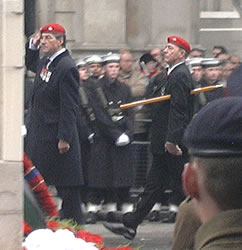 Saluting the Cenotaph
Saluting the Cenotaph |
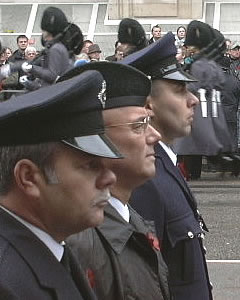 Remembering the dead
Remembering the dead |
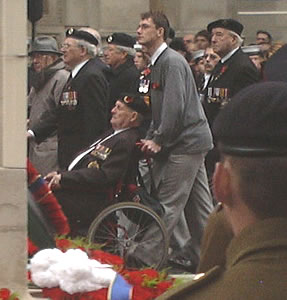 War veterans wear their medals
War veterans wear their medals |
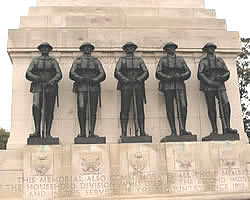 The Guards Memorial
The Guards Memorial |
During the First World War, many people died in the fields of France and Belgium.
The fields in Flanders turned red because many poppies (a small flower which has
red petals) suddenly appeared there. This seemed to symbolise the spirits of the
dead soldiers, especially because the colour is similar to blood. The Canadian
poet John McCrae wrote a poem called In Flanders Fields which drew people's attention
to the poppies (you can read or listen to this poem: here).
It is common for poppy seeds to remain in the ground for a long time and for the
flowers to grow after the ground has been disturbed, as had happened because of
the war.
The widows of dead soldiers suggested that poppies be sold to raise money for
people who were in need of help because of the death or injury of someone in the
war. Each year (at the beginning of November) you can buy a poppy from a collector
- the amount you want to pay is up to you. People wear the poppy from early November
until 11th November. The money is used to help families affected because of service
in all wars - not just the World Wars.
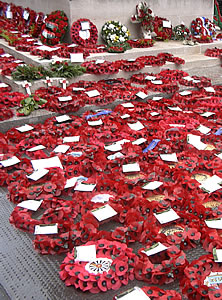 Poppy wreathes at the Cenotaph
Poppy wreathes at the Cenotaph |
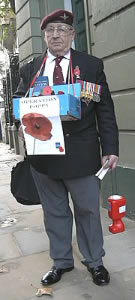
Poppy seller |
Back to top
FURTHER INFORMATION
Royal British Legion poppy appeal: http://www.poppy.org.uk.
Commonwealth War Graves Commission: http://www.cwgc.org
Armed Forces Memorial at the National Memorial Arboretum, Staffordshire: http://www.nationalmemorialarboretum.org.uk
Back to top
LINKS
Events in the UK in November: Ideas/Events/November
British royal family: Britain/Countries/Royalty
Modern British history: Britain/History/Modern
Pictures from other traditional events in Britain: Ideas/Album
Photos from Trooping the Colour: Ideas/Album/TroopingTheColour
State Opening of Parliament: Ideas/Album/StateOpeningOfParliament
Home page: Home
Back to top
© UK Student Life 2002-2011
* Search this website (www.ukstudentlife.com) or the web:




















